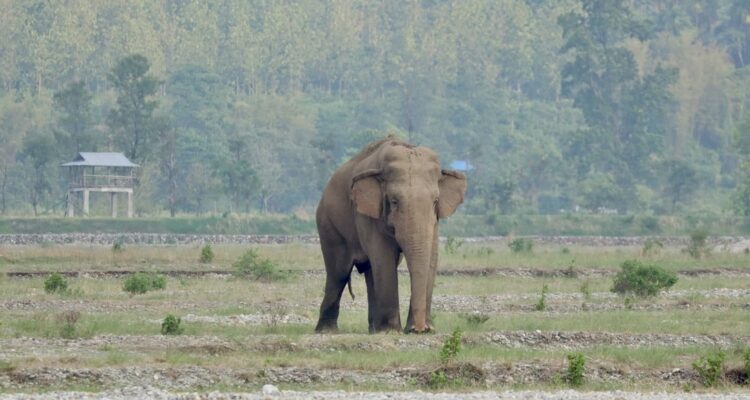Earlier this year, in April, I returned to Nepal to continue my work with Human-elephant conflict (HEC) mitigation. The trip would give me the opportunity to visit field sites considered hot spots for HEC and serve as a proof-of-concept for a much bigger expedition wherein I would travel the entire historic elephant range in the Chure Terai Madesh Landscape (CTML).
To get a better understanding of the history and magnitude of HEC, I met with the Director of the International Union for the Conservation of Nature (IUCN) for Nepal, Dr. Narendra Pradesh, in Kathmandu. Narendra explained that since the eradication of malaria in the 1950s, the CTML has experienced a significant increase in human population and linear infrastructure. A 2021 census revealed that 52% (17.5 million) of Nepal’s human population now reside in this area. People living well-below the national poverty line in the central hill country located between the CTML and Himalaya were given the opportunity to relocate to the CTML. This resulted in the large-scale conversion of pristine intact forest into agricultural lands for livestock rearing, subsistence farming, and cash-crops. Unfortunately, the resettlement program has had negative impacts on the environment, resulting in a significant decrease in historic forest, grasslands, and wetlands, and plummeting wildlife population. Fortunately, in the 1970s, Nepal recognized a dangerous trend and began designating Protected Areas to establish safe havens for wildlife. However, the response may not have occurred fast enough. In 1983, the World Bank estimated a 50% loss of forest cover in the lowlands of Nepal. Loss of habitat has caused forest fragmentation, forcing humans and wildlife closer together, competing for natural resources triggering an increase in human-wildlife conflict (HWC) including HEC.
Despite a current elephant population at 200-220 individuals, documented cases of HEC are on the rise. Conflicts with elephants can be categorized as damage to crops, damage to property, livestock loss, and/or damage to a person resulting in injury or. It is unknown exactly when HEC became commonplace in Nepal as documented incidences only began in 1998. Since that time, there are nearly 1,000 reported cases per year of which ~15 resulted in human deaths. Interestingly, from 2018 to present, HEC escalated rapidly resulting in a total of 85 human deaths and 30 retaliatory elephant deaths. Note, these incidents are very location-specific with 70% of all HEC documented from just two areas, Bardia and Jhapa. The latter being my first stop on my journey.
To combat the loss in biodiversity following the human resettlement programs in the CTML, the GoN began establishing protected areas such as National Parks. Working through the Departments of Forests and Soil Conservation (DFSC) and National Parks and Wildlife Conservation (NPWC), they developed programs to conserve the little remaining forest and protect wildlife. Unfortunately, the implementation of the “Fortress-and-Fines” model in the 1970s alienated local people, denying them resource extraction rights in designated protected areas. Human settlements were limited to buffer zones surrounding protected areas and human access to forests severely restricted, promoting negative attitudes toward conservation. In many cases, these actions had detrimental effects on the indigenous peoples and local communities as they were not consulted.
Marginalized people currently living in buffer zones moved to the Terai region during the land resettlement program in the late 1950s. Until that point, they had never experienced elephants. They were mostly subsistence farmers grazing livestock and growing crops in terraces on the slopes of the Churai foothills. Due to their lack of knowledge, low socioeconomic status, and limited resources, they are at the highest risk of HWC resulting in the loss of crops, property, livelihoods, and/or life. In contrast, Indigenous peoples have lived in the CTML for centuries, regardless of malaria and historic numbers of wildlife, and thrived. Using knowledge passed through generations, forests, grasslands, and watersheds were managed, while wildlife populations flourished. The Indigenous traveled daily into wildlife habitat and lived near forests in a peaceful coexistence. Yet, they were not included as conservation stakeholders during the establishment of protected areas or planning of resettlements. Most of their stories and perceptions of conflict and coexistence has never been documented.
Published research in 2021 from the University of East Anglia in collaboration with the French Federation for Research on Biodiversity (FRB) found that conservation success is the exception not the rule. Investigating the outcomes of 169 global conservation projects, including community forests in Nepal, the governance and decision making of conservation programs has direct effects on nature and the well-being of indigenous people and local communities. Conservation initiatives that were unsuccessful failed to include indigenous peoples and local communities, disregarding their knowledge and expertise. Instead, they need to be given the support and autonomy to spearhead conservation efforts supported by government and NGOs with funding, education, promotion of community cohesion and social inclusion with policies and laws that recognize and protect their knowledge, cultural practices, and decision-making.
Located in the southeastern most district of Jhapa, Bahundangi Village has been a model for landscape-level elephant conservation success. Although Bahundangi has only 15-20 resident elephants, during the harvest, more than 100 elephants may cross the Mechi River from West Bengal, India and enter the village. Conflict that occurs between humans and elephants during this time contributes to Jhapa being considered an HEC hotspot with the second highest number of incidences in the country. However, for one ward within Bahundangi, Mechinager-4, not only is HEC a rare occurrence, the peaceful coexistence between people and elephants is promoted thanks to elephant champion, Shankar Luitel.
The work below was the product of my time spent with Shankar. My hope was to highlight the landscape-level elephant conservation initiatives used to mitigate HEC and those individuals who work tirelessly to protect all. My article can be found on page 69 (or 25 of the pdf). Enjoy!
